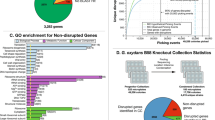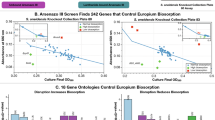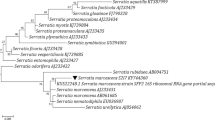Abstract
Thousands of waste sites around the world contain mixtures of toxic chlorinated solvents, hydrocarbon solvents, and radionuclides. Because of the inherent danger and expense of cleaning up such wastes by physicochemical methods, other methods are being pursued for cleanup of those sites. One alternative is to engineer radiation-resistant microbes that degrade or transform such wastes to less hazardous mixtures. We describe the construction and characterization of recombinant Deinococcus radiodurans, the most radiation-resistant organism known, expressing toluene dioxygenase (TDO). Cloning of the tod genes (which encode the multicomponent TDO) into the chromosome of this bacterium imparted to the strain the ability to oxidize toluene, chlorobenzene, 3,4-dichloro-1-butene, and indole. The recombinant strain was capable of growth and functional synthesis of TDO in the highly irradiating environment (60 Gy/h) of a 137Cs irradiator, where 5×108 cells/ml degraded 125 nmol/ml of chlorobenzene in 150 min. D. radiodurans strains were also tolerant to the solvent effects of toluene and trichloroethylene at levels exceeding those of many radioactive waste sites. These data support the prospective use of engineered D. radiodurans for bioremediation of mixed wastes containing both radionuclides and organic solvents.
This is a preview of subscription content, access via your institution
Access options
Subscribe to this journal
Receive 12 print issues and online access
$209.00 per year
only $17.42 per issue
Buy this article
- Purchase on Springer Link
- Instant access to full article PDF
Prices may be subject to local taxes which are calculated during checkout
Similar content being viewed by others
References
McKlveen, J.W. 1990. Current status of nuclear power in the United States and around the world. Australas Phys. Eng. Sci. Med. 13: 101–109.
Macilwain, C. 1996. Science seeks weapons clean-up role. Nature 383: 375–379.
Riley, R.G., Zachara, J.M., & Wobber, F.J. 1992. Chemical contaminants on DOE lands and selection of contaminant mixtures for subsurface science research. US Dept. of Energy. Subsurface Science Program, Washington, DC.
US General Accounting Office 1988. Nuclear waste problems associated with DOE's inactive waste sites. GAGO/RCED-88-229FS, US Government Accounting Office, Washington, DC.
http://www.em.doe.gov/bemr96. The 1996 Baseline Environmental Management Report.
Diels, L., Dong, Q., Van der Lelie, D., Baeyens W., and Mergeay, M. 1995. The czc operon of Alcaligenes eutrophus CH34: from resistance mechanism to the removal of heavy metals. J. Ind. Microbiol. 14: 142–153.
Leisinger, T., Cook, A.M., Hutter, R., and Nuesch, J. (eds.). 1981. Microbial degradation of xenobiotic and recalcitrant compounds. Academic Press, New York.
Li, S. and Wackett L.P. 1992. Trichloroethylene oxidation by toluene dioxygenase. Biochem. Biophys. Res. Commun. 58: 2820–2826.
Lovely, D.R. 1995. Bioremediation of organic and metal contaminants with dissimilatory metal reduction. J. Ind. Microbiol. 14: 85–93.
Nies,D.H. and Silver, S. 1994. Ion efflux systems involved in bacterial metal resistances. J. Ind. Microbiol. 14: 186–199.
Wackett, L.P., Sadowsky, M.J., Newman, L.M., Hur, H.-G. and Li, S. Metabolism of polyhalogenated compounds by a genetically engineered bacterium. Nature 368: 627–629.
Zylstra, G.J. and Gibson, D.T. 1989. Toluene degradation by Pseudomonas putida F1: Nucleotide sequence of the todC1C2BADE genes and their expression. J. Biol. Chem. 264: 14940–14946.
Thornley, M.J. 1963. Radiation resistance among bacteria. J. Appl. Bacteriol. 26: 334–345.
Brooks, B.W., Murray, R.G.E., Johnson, J.L., Stackebrandt, E., Woese, C.R. and Fox, G.E. 1980. Red-pigmented micrococci: a basis for taxonomy. Int. J. Syst. Bacteriol. 30: 627–646.
Moseley, B.E.B. and Evans, D.M. 1983. Isolation and properties of strains of Micrococcus (Deinococcus) radiodurans unable to excise ultraviolet light-induced pyrimidine dimers from DNA: evidence for two excision pathways. J. Gen Microbiol. 129: 2437–2445.
Murray, R.G.E. 1992. The family Deinococcaceae, pp. 3732–3744, in The prokaryotes. Balows, A., Truper, H.G., Dworkin, M., Harder, W., and Schleifer, K.-H. (eds.) Vol. 4, 2nd ed. Springer-Verlag, New York.
Mattimore, V. and Battista, J.R. 1996. Radioresistance of Deinococcus radiodurans: functions necessary to survive ionizing radiation are also necessary to survive prolonged desiccation. J. Bacteriol. 177: 5232–5237.
Daly, M.J. Ouyang, L., and Minton, K.W. 1994. In vivo damage and recA-dependent repair of plasmid and chromosomal DNA in the radioresistant bacterium Deinococcus radiodurans. J. Bacteriol. 176: 3508–3517 (1994)
Krasin, F. and Hutchinson, F. 1977. Repair of DNA double-strand breaks in Escherichia coli, which requires recA function and the presence of a duplicate chromosome. J. Mol. Biol. 116: 81–98.
Daly, M.J. and Minton, K.W. 1995. Interchromosomal recombination in the extremely radioresistant bacterium Deinococcus radiodurans. J. Bacteriol. 176: 7506–7515.
Daly, M.J. and Minton, K.W. 1996. An alternative pathway for recombination of chromosomal fragments precedes recA-dependent recombination in the radioresistant bacterium Deinococcus radiodurans. J. Bacteriol. 178: 4461–4471.
Smith, M.D., Lennon, E., McNeil,L.B., and Minton, K.W. 1988. Duplication insertion of drug resistance determinants in the radioresistant bacterium Deinococcus radiodurans. J. Bacteriol. 170: 2126–2135.
Carroll, J.D., Daly, M.J. and Minton, K.W. 1996. Expression of recA in Deinococcus radiodurans. J. Bacteriol. 178: 130–135.
Daly, M.J. and Minton, K.W. 1997. Recombination between a resident plasmid and the chromosome following irradiation of the radioresistant bacterium Deinococcus radiodurans. Gene 187: 225–229.
Minton, K.W. 1994. DNA repair in the extremely radioresistant bacterium Deinococcus radiodurans. Mol. Microbiol. 13: 9–15.
Minton, K.W. 196. DNA repair in the extremely radioresistant bacterium Deinococcus radiodurans. Mol. Microbiol. 13: 9–15.
http://www.tigr.org/tigr_home/index.html. The Institute for Genomic Research
Wackett, L.P. 1990. Toluene dioxygenase. Methods Enzymol. 188: 39–45.
ftp://ftp.tigr.org/pub/dataALradiodurans. D. radiodurans sequence.
Ensley, B.D., Ratzkin, B.J., Osslund, T.D., Simpson, M.J., Wackett, L.P., and Gibson, D.T. 1983. Expression of the naphthalene oxidation genes in Escherichia coli results in the biosynthesis of indigo. Science 222: 167–169.
Wackett, L.P. and Householder, S.R. 1989. Toxicitiy of trichloroethylene to Pseudomonas putida F1 is mediated by toluene dioxygenase. Appl. Environ. Microbiol. 55: 2723–2725.
Thompson, B.G. and Murray, R.G.E. 1982. The fenestrated peptidoglycan layer of Deinococcus radiodurans. Can. J. Microbiol. 28: 522–525.
Thompson, B.G. and Murray, R.G.E. 1982 The association of the surface array and the outer membrane of Deinococcus radiodurans. Can J. Microbiol. 28: 1081–1088.
de Smet,M.J., Kingma, J., and Witholt, B. 1978. The effect of toluene on the structure and permeability of the outer and cytoplasmic membranes of Escherichia coli. Biochem. Biophys. Act. 506: 64–80.
Sikkema, J., de Bont, J.A., and Poolman, B. 1995. Mechanisms of membrane toxicity of hydrocarbons. Microbiol. Rev. 59: 201–222.
Lange, C.C. and Wackett, L.P. 1997. Oxidation of aliphatic olefins by toluene dioxygenase: enzyme rates and product identification. J. Bacteriol. 179: 3858–3865.
Ziffer, H., Kabuto, K., Gibson, D.T., Kobal, V.M. and Jerina, D.M. The absolute sterochemistry of several cfe-dihydrodiols microbially produced from substituted benzenes. Tetrahedron 33: 2491–2496.
Sambrook, J., Fritsch, E.F. and Maniatis, T. 1989. Molecular cloning: a laboratory manual. 2nd ed. Cold Spring Harbor Laboratory Press, Cold Spring Harbor, NY.
Author information
Authors and Affiliations
Rights and permissions
About this article
Cite this article
Lange, C., Wackett, L., Minton, K. et al. Engineering a recombinant Deinococcus radiodurans for organopollutant degradation in radioactive mixed waste environments. Nat Biotechnol 16, 929–933 (1998). https://doi.org/10.1038/nbt1098-929
Received:
Accepted:
Issue Date:
DOI: https://doi.org/10.1038/nbt1098-929
This article is cited by
-
Isolation and screening of bacteria from radionuclide containing soil for bioremediation of contaminated sites
Environmental Sustainability (2019)



